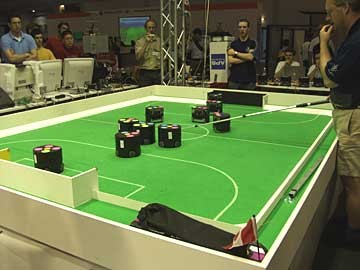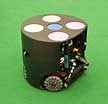Cornell's student RoboCup team wins world title for the fourth time
By Bill Steele
For the fourth time in five years, Cornell University's Big Red team has won the international robot soccer competition, known as RoboCup. In finals of the latest competition, held July 2-11 in Padua, Italy, a team of pint-sized robot players built and programmed by Cornell engineering students narrowly beat the RoboRoos from the University of Queensland, Australia, 1-0.
In the RoboCup competition, teams of robots play soccer under computer control, without human intervention. The game is a test of artificial intelligence as well as engineering. In the "small robots" league where Cornell competes, the robots are about the size of a cookie jar and play with a golf ball on a field about the size of two ping-pong. A video camera mounted above the playing field supplies an image to a computer that determines the location of the ball and of every robot. From this, another computer determines strategy and sends commands by radio to each robot on the team.
The competition also includes leagues with larger rolling robots, robots that play on four legs instead of wheels and a simulation league in which games are played entirely inside a computer, as a pure test of artificial intelligence. There also are demonstrations of prototype humanoid robots. The stated goal is to have a team of robots that can compete against people by 2050.
Raffaello D'Andrea, Cornell associate professor of mechanical and aerospace engineering, coaches the Big Red team and attributes its success to the fact that the team includes mechanical and electrical engineers as well as computer scientists. Consistently, Cornell's robots are the fastest and strongest, as well as the best controlled. Although the team faced many problems this year, D'Andrea said the win was due to the team's ability to solve problems in the field. When the Cornell students arrived in Padua, they found that most other teams had adopted innovations Cornell introduced in 2000, including an omnidirectional drive that allows the robots to move sideways or backward as easily as forward and a "dribbling bar" that allows a robot to hold the ball and move with it.
"The problem is that many teams had better versions of what we introduced," D'Andrea reported. "The Australian's dribblers were better than ours. The RoboDragons [from Japan] had a working chip kicker that could kick over other robots, which we haphazardly introduced in 2002. Several teams could pass better than we could, even though we introduced passing in 2000."
But Cornell had improved its own robots with new high-friction wheels, a more powerful solenoid-driven kicker, a better power transmission system, enabling them to move faster, and a control system that gave precise control at the higher speeds. The Cornell robots have inertial sensors that supply more information about the robot's movements than the overhead camera, allowing the robot to follow the computer's commands correctly even if the wheels are slipping.
Unfortunately not all of this was working perfectly, and when the Cornell engineers arrived in Padua they found some new rules to which they had to adapt their software. They also had to make changes to accommodate a new type of ball and a different playing surface from the one they had used for testing. The team spent its first few days in Padua testing, modifying and fixing and, in some cases, writing new computer code from scratch -- "mostly by sleeping three hours a night," D'Andrea said.
In the first round-robin games, Cornell squeaked by in a couple of matches against other teams also suffering malfunctions but lost to the RoboRoos. After fixing some problems with the vision system, they barely won a second round-robin and advanced to the semifinals. In the semis, Cornell faced the FU Fighters of the Freie Universität of Berlin, one of the strongest teams and an archrival. The two teams rapidly traded goals, ending regulation play tied at 4-4. In sudden-death overtime, with "everything turned on high," D'Andrea said, the Big Red scored a single goal to win 5-4.
In the final against the RoboRoos, the Big Red suffered a penalty that removed one robot from the field but still managed a solid defense, even turning back a free kick. The game went into overtime at 0-0, and in the second and last sudden-death period, Cornell finally scored to win 1-0. RoboCup was launched in 1997. Cornell entered for the first time in Sweden in 1999, and that year the Big Red won its first RoboCup championship by beating the FU Fighters 15-0 in a match broadcast live on Swedish television. The following year, Cornell again beat the FU Fighters. In 2001 Cornell lost to an unusual, and since-outlawed, stalling strategy by the Singapore Polytechnic Field Rangers and ended up with a third-place finish. Last year in Fukuoka, Japan, the Big Red again beat the FU Fighters 7-3 in the finals.
"Our win this year was by far the sweetest of all," D'Andrea concluded. "We overcame many obstacles to win; we were essentially written off by most of the good teams at the competition. We can think back on at least 10 critical points at the tournament where, if we had not solved that particular problem, we would not have won."
The 2003 Big Red student team members included:
Software engineering: Prabhu Ram Raghunathan, Walter Chen, Mike Covelli, Eugene Bryne, Joran Siu, Joseph Loomis, Jason Palmer, Prachi Pandit, Sergei Lupashin, Jeffery Zhang, Yuval Shavit, Kevin Markman, Likai (David) Wu, Tsi Wan Panella Pan, and Yong Jae Kwon.
Electrical design: Jin Woo Lee, Wei Feng Li, Gregory Peng, Allen Hou, Sudheery Tyagi, Shantini Supramaniam, Aaron Nathan, Elliott Cheung, Carlo Soracco, Shing Tak, Emmy Lai, and Tolu Odumosu.
Mechanical design: Ken Sterk, Patrick Dingle, Christine Chang, Hank Law, Graham Andersen, Len Evansic, Sean R. Richardson, David Chung, Jeremy Miller, Oliver Purwin, Jeremy Yim, and John Roberts.
Media Contact
Get Cornell news delivered right to your inbox.
Subscribe
